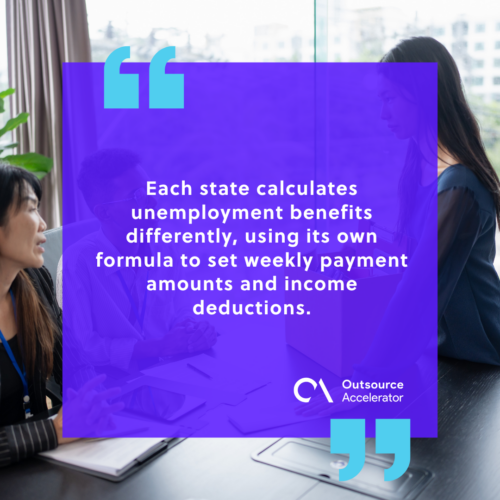How much does unemployment pay: A state-by-state guide

Unemployment benefits vary widely across the United States, leaving many job seekers wondering, how much does unemployment pay in their state. Each state sets its own rules for payment amounts, duration, and eligibility.
Some offer higher weekly benefits, while others provide limited support. Knowing these differences can help individuals plan their next steps during periods of job loss.
This state-by-state guide breaks down what to expect from unemployment benefits, giving firms a clearer view of potential support in each location.
How much does unemployment pay: Must-know terminologies
Determining unemployment benefits starts with knowing the common terms used during the application and payment process. These terms impact how much support an individual can receive and for how long.
Below are four key terminologies every applicant should know when asking: How much does unemployment pay?
Base period
The base period refers to the time frame states use to calculate benefit eligibility. It typically covers the first four of the last five completed calendar quarters before the claim is filed.
States examine earnings during this period to decide if a worker qualifies. If earnings are too low, an alternate base period may be used, often covering the most recent four quarters.
Earnings disregard
Some states allow part-time workers to earn a limited amount without significantly lowering their unemployment benefits.
This is known as the earnings disregard. For instance, if the disregard is $50 and someone earns $300, only $250 counts against their weekly benefit.
Workers must report gross income (what they earned before taxes) for the week it was earned.

Benefit weeks
Benefit weeks refer to the number of weeks a person can receive unemployment payments. Most states offer up to 26 weeks. However, if someone qualifies for partial benefits, those payments may be stretched across more weeks, depending on the total cap.
Weekly benefit
This is the amount paid per week to eligible applicants. Each state sets a minimum and maximum rate. This figure doesn’t include previous federal boosts like the $600 weekly PUA supplement, which ended in 2021.
How much does unemployment pay: Calculations per state
Here’s a breakdown of how unemployment benefits are calculated per US state:
1. Alabama
Alabama calculates weekly benefits as 1/26 of the average earnings in the two highest recent quarters. Weekly benefits range from $45 to $275. Part‑time income has a disregard equal to one‑third of the weekly benefit, which helps reduce benefit cuts.
Maximum benefit coverage lasts 14 weeks. States use this method to credit recent earnings while offering limited income smoothing.
2. Alaska
Alaska determines the weekly benefit based on a benefits chart tied to total income across four of the last five calendar quarters. Weekly benefits start at $56 and cap at $370.
Alaska disregards $50 plus one‑fourth of earnings above $50 when individuals collect income while receiving benefits. Benefit coverage in Alaska extends up to 26 weeks to offer extended support.
3. Arizona
Arizona sets weekly benefits at 1/25 of earnings in the highest quarter of the base period. Minimum benefit is $200 and the maximum is $320. The state disregards $160 of earnings when recipients collect income.
Standard eligibility covers up to 26 weeks, but if unemployment falls under 5%, allowable weeks can decline to 24. This maintains cost effectiveness while supporting workers.
4. Arkansas
Arkansas uses 1/26 of the average earnings across the last four quarters to determine weekly benefits. The minimum rate is $81 and maximum reaches $451.
Arkansas disregards 40% of the weekly benefit amount when an individual earns supplemental income. Maximum eligibility lasts 16 weeks, which reflects the state’s more limited duration compared to many others.
5. California
California relies on a benefits chart tied to income in the highest quarter of the last four. Weekly benefits range from $40 to $450. The disregard equals $25 or one‑quarter of earnings, whichever is greater, when an individual works part‑time.
Benefit coverage extends up to 26 weeks, providing a balance between adequacy and cost control within a large state system.
6. Colorado
Colorado calculates the higher of two methods: 60% of average weekly earnings in the top two consecutive quarters or 50% of average weekly earnings over the past 12 months. Weekly benefits begin at $25 and can reach $781.
A disregard equal to 25% of the weekly benefit applies to collected income. Individuals remain eligible for up to 26 weeks of support.
7. Connecticut
Connecticut determines weekly benefits by dividing average earnings in the two highest recent quarters by 26. Benefit amounts range from $15 to $780. The earnings disregard equals one‑third of weekly gross earnings.
Benefit eligibility lasts up to 26 weeks, aligning with the state’s structured and supportive unemployment system for eligible workers.
8. Delaware
Delaware computes weekly benefits as 1/46 of average earnings in the two top quarters. Eligible applicants can receive between $20 and $450 per week. When collecting extra income, the disregard is $10 or half the weekly benefit amount, whichever is greater.
Delaware offers up to 26 weeks of benefits, similar to many states in duration.
9. District of Columbia
The District of Columbia calculates weekly unemployment benefits as 1/26 of earnings in the highest quarter of the base period. This yields weekly payments from $50 to $444.
While collecting earnings, claimants may disregard one‑third of wages plus $50. Benefit coverage runs up to 26 weeks, offering metropolitan claimants moderate-term assistance.
10. Florida
Florida sets weekly benefits at 1/26 of earnings during the highest quarter of the base period. Weekly amounts range between $32 and $275. The state disregards eight times the federal minimum wage when recipients collect income.
Maximum coverage lasts only 12 weeks, reflecting Florida’s shorter duration relative to most states’ unemployment programs.
11. Georgia
Georgia allows claimants to choose between two calculations: 1/42 of earnings from the two highest quarters or 1/21 of earnings in the highest quarter. Weekly benefits range from $55 to $365. A $50 disregard applies when collecting income.
Benefit eligibility reaches up to 20 weeks, offering a moderate blend of support and duration.
12. Hawaii
Hawaii sets weekly benefits at 1/21 of earnings in the highest quarter of the base period. Weekly benefits range from $5 to $796. The state allows a $150 disregard of earnings while claiming benefits.
Applicants can receive support for up to 26 weeks, consistent with many others in providing up to half a year of assistance.
13. Idaho
Idaho calculates benefits at 1/26 of earnings in the highest quarter of the base period. Weekly payments range between $72 and $499. Idaho disregards half of the weekly benefit amount when recipients collect income.
Eligibility runs up to 20 weeks, offering shorter-term support compared to those states that reach 26 weeks.
14. Illinois
Illinois awards weekly benefits as 47% of average weekly earnings across the two highest-earning quarters. Weekly payouts range from $51 to $787. While collecting income, recipients may disregard one-half of their weekly benefit.
Benefit eligibility spans up to 26 weeks, offering generous potential support levels for eligible applicants.
15. Indiana
Indiana bases its weekly benefit on 47% of average weekly earnings during the base period. Illinois residents receive between $37 and $390 per week. The disregard equals $3 or 20% of the weekly benefit from non‑employer earnings, whichever is greater.
Benefit coverage lasts up to 26 weeks, following a typical state structure.
16. Iowa
Iowa uses 1/23 of earnings in the highest quarter or more if the applicant has dependents. Weekly benefits range between $72 and $714. The state disregards half of the weekly benefit amount when recipients collect extra income.
Maximum eligibility lasts 26 weeks, matching many states’ standard duration for support.
17. Kansas
Kansas determines weekly benefits by taking 4.25% of earnings in the highest quarter of the base period. Recipients may receive between $147 and $549 per week. A disregard equal to 25% of the weekly benefit plays a role when claimants collect income.
Benefit coverage extends up to 26 weeks, consistent with standard policy length.
18. Kentucky
Kentucky calculates weekly benefits at 1.1923% of base period earnings. Weekly amounts range from $39 to $665. The state disregards 20% of earnings collected while claiming benefits.
Benefit eligibility lasts up to 26 weeks, aligning with its regional peers’ typical structure for support duration.
19. Louisiana
Louisiana sets the weekly benefit as 1/25 of average base period earnings multiplied by 1.2075. Weekly payouts range between $10 and $275. A disregard of either $50 or half the weekly benefit, whichever is less, applies when collecting income.
Eligible individuals may receive benefits for up to 26 weeks.
20. Maine
Maine uses 1/22 of average earnings in the two highest recent quarters. Weekly benefits range from $80 to $462. A $100 disregard applies when part-time income is earned.
The state allows up to 26 weeks of benefit coverage, supporting workers for up to half a year of unemployment-related need.
21. Maryland
Maryland calculates weekly benefits at 1/24 of earnings in the highest quarter. Weekly payouts range from $50 to $430. The disregard equals $50 when collecting earnings.
Applicants may receive benefits for up to 26 weeks, offering moderate support aligned with many East Coast states.
22. Massachusetts
Massachusetts calculates weekly benefits at 50% of average weekly earnings. Weekly benefits range between $98 and $1,033. The state disregards one‑third of the weekly benefit when recipients collect income.
Coverage may extend up to 26 weeks, providing relatively high benefit potential for eligible individuals.
23. Michigan
Michigan sets weekly benefits as 4.1% of earnings in the highest quarter of the base period. Saint State offers between $150 and $362 per week. Income collected while on benefits triggers a disregard equal to half of the earnings.
Benefit eligibility runs up to 20 weeks, offering shorter duration support.
24. Minnesota
Minnesota calculates weekly benefits using the higher of two methods: 50% of 1/13 of earnings in the highest quarter or 50% of 1/52 of average weekly earnings over the base period. Weekly benefit amounts range from $28 to $890.
The state disregards half of the earnings collected. Applicants remain eligible for up to 26 weeks of support.
25. Mississippi
Mississippi awards weekly benefits at 1/26 of earnings in the highest quarter of the base period. Weekly benefits fall between $30 and $235. The state disregards a flat $40 in collected earnings.
Benefit eligibility extends up to 26 weeks, offering short‑term support at modest benefits.
26. Missouri
Missouri uses 1/25 of average earnings in the two highest recent quarters to calculate weekly benefits. Weekly payouts range from $35 to $320. While collecting income, recipients may disregard $20 or 20% of the weekly benefit, whichever is higher.
Benefit coverage lasts up to 26 weeks, following standard maximum duration norms.
27. Montana
Montana calculates weekly benefits as 1% of base period earnings or 1.9% of earnings in the two highest recent quarters, whichever yields a larger sum.
Weekly benefits range between $163 and $552. A disregard equal to one‑fourth of the weekly benefit applies when collecting income.
Benefit coverage extends up to 20 weeks.
28. Nebraska
Nebraska sets weekly benefits at 50% of average weekly earnings during the base period. Weekly amounts range from $70 to $546. The state disregards one‑half of the weekly benefit while the applicant collects income.
Eligible workers may receive up to 26 weeks of benefits, placing Nebraska within the common benefit duration range.
29. Nevada
In Nevada, unemployment benefits are calculated as 1/25th of a worker’s earnings in the highest quarter of their base period. The minimum benefit a Nevadan can receive is $16 per week, while the maximum is $469.
When a claimant earns part-time income, the state disregards 25% of wages. Nevada offers unemployment coverage for up to 26 weeks.
30. New Hampshire
New Hampshire calculates weekly unemployment benefits as 1% to 1.1% of a worker’s annual earnings. The state offers a minimum of $32 and a maximum of $427 per week.
If the claimant earns income during a benefit week, New Hampshire disregards 30% of the weekly benefit amount. Eligible individuals may receive benefits for a maximum of 26 weeks.
31. New Jersey
In New Jersey, unemployment benefits amount to 60% of the claimant’s average weekly wages during the base period. Weekly payments range from a minimum of $120 to a maximum of $830.
When part-time income is earned, New Jersey disregards either $5 or 20% of the benefit amount, whichever is greater. Coverage lasts up to 26 weeks.
32. New Mexico
New Mexico calculates weekly unemployment benefits as 53.5% of a worker’s average weekly wage in the highest-earning quarter of the base period. Weekly benefits range from $86 to $511.
If claimants earn income, the state disregards 1/5th of their benefit amount. The maximum duration for collecting unemployment benefits is 26 weeks.
33. New York
New York calculates weekly benefits as 1/25th to 1/26th of the claimant’s highest quarterly earnings in the base period. Weekly payments fall between $104 and $504. The state does not disregard any additional income earned during the benefit period.
New Yorkers can receive unemployment benefits for up to 26 weeks.
34. North Carolina
In North Carolina, weekly unemployment benefits are based on total earnings from the last two quarters divided by 52. The minimum payout is $15, while the maximum is $350 per week.
If a claimant works part-time, the state disregards 20% of their weekly benefit amount. Benefit coverage lasts for a maximum of 12 weeks.
35. North Dakota
North Dakota calculates unemployment benefits as 1/65th of the sum of the two highest quarters’ earnings, plus half of the third-highest quarter’s earnings. Weekly benefits range from $48 to $748.
The state disregards 60% of the weekly benefit amount if claimants earn income. The duration for unemployment coverage is capped at 26 weeks.
36. Ohio
Ohio provides unemployment benefits equal to 50% of a claimant’s average weekly wage during the base period. Weekly amounts range from a minimum of $157 to a maximum of $757.
If part-time income is earned, the state disregards 20% of the benefit amount. Unemployment compensation in Ohio is available for up to 26 weeks.
37. Oklahoma
In Oklahoma, weekly unemployment benefits are calculated as 1/23rd of a claimant’s earnings during their highest-paid quarter. Benefits range between $16 and $539 per week.
When a person earns income while receiving benefits, the state disregards up to $100. The coverage period for unemployment compensation is limited to 26 weeks.
38. Oregon
Oregon calculates weekly unemployment benefits as 1.25% of a claimant’s total earnings from the base period. Weekly payments range from $190 to $813.
If a worker earns income while receiving benefits, the state disregards either $125 or one-third of the benefit amount, whichever is higher.
Oregon allows up to 26 weeks of unemployment compensation.
39. Pennsylvania
In Pennsylvania, unemployment benefits equal 4% of earnings from the highest quarter, plus $2, then multiplied by 0.98. Claimants receive between $68 and $605 per week.
When income is earned during the benefit period, Pennsylvania disregards either $21 or 30% of the weekly benefit, whichever amount is greater.
Benefit payments last for up to 26 weeks.
40. Puerto Rico
Puerto Rico calculates unemployment benefits using a range between 1/11th and 1/26th of a claimant’s highest quarterly earnings. Weekly payments fall between $33 and $190.
If income is earned while collecting benefits, Puerto Rico deducts the full amount from the benefit payment.
Eligible claimants may receive benefits for a maximum of 26 weeks.
41. Rhode Island
Rhode Island determines weekly unemployment benefits as 3.85% of the average earnings in the two highest quarters of the base period.
Claimants may receive between $71 and $705 weekly. If they work part-time, the state disregards 1/5th of the weekly benefit amount.
Rhode Island allows up to 26 weeks of unemployment compensation.
42. South Carolina
In South Carolina, weekly benefits are calculated as half of a worker’s average weekly wage from the highest-earning quarter. Payments range from $42 to $326.
When income is earned during the benefit period, South Carolina disregards 25% of the weekly benefit amount. The state limits unemployment coverage to a maximum of 20 weeks.
43. South Dakota
South Dakota provides unemployment benefits equal to 1/26th of the claimant’s earnings in the highest-paid quarter.
The state pays between $28 and $514 per week. If a claimant works while receiving benefits, South Dakota disregards 25% of wages earned beyond $25.
Unemployment benefits are available for up to 26 weeks.
44. Tennessee
Tennessee calculates weekly benefits as 1/26th of a worker’s earnings in the highest quarter of their base period. Weekly payments range from $30 to $275. If claimants earn income, Tennessee disregards either $50 or 25% of their weekly benefit, whichever is greater.
The state provides up to 26 weeks of unemployment benefits.
45. Texas
Texas determines unemployment benefits as 1/25th of earnings in the highest-paid quarter, capped at 47.6% of the average weekly wage in covered employment.
Weekly benefits range from $73 to $577. If part-time income is earned, Texas disregards $5 or 25% of the benefit amount, whichever is more.
The state allows up to 26 weeks of coverage.
46. Utah
Utah calculates unemployment benefits as 1/26th of the highest quarter’s earnings minus $5. Weekly payments range from $28 to $746. If claimants earn income while receiving benefits, the state disregards 30% of the weekly benefit amount.
Unemployment benefits in Utah are available for up to 26 weeks.
47. Vermont
Vermont determines unemployment benefits using 1/45th of a worker’s earnings from the two highest quarters in the base period. Payments fall between $72 and $705 per week.
Vermont disregards 50% of gross wages when claimants earn income during the benefit period. The state offers up to 26 weeks of unemployment benefits.
48. Virginia
Virginia calculates weekly unemployment benefits as 1/26th of a claimant’s earnings from the highest quarter in the base period. Weekly payments range from $33 to $378. If the recipient earns wages while collecting benefits, Virginia disregards 25% of earnings above $15.
The state provides unemployment compensation for a maximum duration of 26 weeks.
49. Washington
Washington determines weekly unemployment benefits using 3.85% of the average earnings from the two highest quarters of the base period. Benefits range from $323 to $1,019 per week.
When a claimant works part-time, Washington disregards 25% of any income exceeding $5. Eligible individuals may receive up to 26 weeks of benefits.
50. West Virginia
West Virginia calculates unemployment payments as 55% of 1/52nd of the median wages within the claimant’s wage class. The weekly benefit amount falls between $24 and $424. If a person earns additional income, West Virginia disregards up to $60.
The unemployment program offers coverage for a maximum of 26 weeks.
51. Wisconsin
In Wisconsin, unemployment benefits equal 1/25th of a claimant’s highest quarterly earnings during the base period. Weekly benefit amounts range from $54 to $370.
If a claimant earns wages, the state disregards $30 plus 33% of any additional income above that amount. Wisconsin offers unemployment coverage for up to 26 weeks.
52. Wyoming
Wyoming determines weekly unemployment benefits as 1/25th of the earnings from the highest quarter of a claimant’s base period. Benefit payments range from $43 to $595 each week.
If part-time wages are earned, Wyoming disregards 50% of the weekly benefit amount. Qualified recipients may receive unemployment compensation for up to 26 weeks.
How much does unemployment pay in your state?
Each state calculates unemployment benefits differently, using its own formula to set weekly payment amounts and income deductions. Some states offer higher benefits or longer coverage, while others cap support at lower amounts.

Knowing how your state handles unemployment claims helps you better understand what to expect during periods of job loss. Always refer to your state’s unemployment office for the latest details on benefit amounts, eligibility rules, and how long payments may last.







 Independent
Independent




